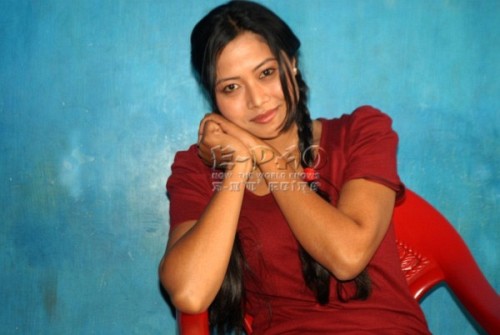Manipuri Cinema, Phijigee Mani, Best Supporting Actress and National Awards
Part 2
Review by Bobby Wahengbam *

Leishangthem Tonthoingambi - Best Supporting Actress (59th National Film Awards 2011)
The contrast of the lifestyles between the open society and the isolated and closed outside is defined quit well visually. The parental home consists of traditional house with Mangol (kind of a porch), gate and courtyard. Mangol is the outer portion used as drawing room/waiting room which is an important essence of 'Manipuriness'. Even reading is carried out here. Yaiphaba does it in this film. It connotes openness with outside environ. We can find Mangols in almost all the Manipuri films.
It contrasts with the isolated fenced house of Sanatomba at Shillong. Manipuri films are questioned for missing the essence of 'Manipuriness' in their body of work and also criticized for remaining hangover of the Bollywood films of the 80/90s . The notion of 'Manipuriness' has been haunting the film makers in Manipur. Nevertheless, there are changes in aesthetic contents but helpless as far as the form is concern. But how much can one experiment in forms while working within the bracket of 'film for the masses'.
And Manipur film is getting a new additional fragrance to the existing rich tradition. Games and Sports has become a new soul of 'Manipuriness'. The state has already made a unique trademark in the field of games and sports. Sports stadia and fields are becoming iconic figures for modern regional Manipuri films. Here, Phijigee Mani exploits Khumanlampak stadia and enhance the production value immensely.
The first half of the film is dedicated to a bus journey from Imphal to Shillong where Yaiphabi is travelling to meet his estranged brother. The story is told from the point of view of Yaiphabi (read, the writer of the film as it is said to be based on real life incident). In order to reveal the story explicitly, it uses personal diary of Sanajaoba (Bonny) as read by Yaiphabi keeping the point of view intact.
Many things, which Yaiphabi hasn't known earlier like the romantic affairs between Sanajaoba and Bicha (Abenao), are unfolded by cross cutting from her journey to the past with the help of the diary. Here, it dexterously weaves the pass with the present using flashback techniques. The expression of Yaiphabi reflexes the complexities faced by people while undergoing trauma and anxiety. The film is lyrical and graceful till Yaiphabi meets her brother.
The pace has a different turn afterwards with lengthy exploration to tourist spots of Shillong. The subplot involving Yaiphabi's uncle and its family members, though speaks volumes of the situation, seems to be overstated. Both the situations could have been exploited forcefully by fabricating the situations with the state of mental stress of Yaiphabi. Except the use of flash backs, the structure is linear and the form, conventional. But as a whole, the film impressively talks with human sentiments, feelings and expression.
Film is now a consumerist art all over the world. The situation is the same in the tiny world of Manipuri cinema. For most of the film makers, the box office collection becomes forefront of their scheme of things. O.Gautam, the director, too could not totally ignore this temptation. In order to attract the common denominators, two conventional background songs are incorporated. At the same time, he wants to share the human pain convincingly and realistically through his film.
In the process, he tries to compromise the two opposite extremes of art and commercial by hunting for the middle route. But the gap is too wide that the two cannot be made meet. O. Gautam could impressively and softly express life's myriad emotions and shades in this oeuvre. Unluckily, some of Gautam's equally good films could not be aesthetically appreciated as digital video format was not recognized for competition earlier. But the experience helps as he has come a long way through to be sensitive to life and film. And equal credit should be given to Bonny, host of other artistes for their impressive performances and the whole unit.
The citation of the award for Phijigee Mani : "For a sensitive depiction of the complex displacements that are occurring today in the North Eastern states. Oinam Gautam Singh shows in the most graceful manner the consequences of displaced socio-political priorities which dislodge the young and disturb traditional family moorings and the even more ancient tribal societal systems."
The mention of tribal societal systems in the citation is debatable.
Soft copies of films are aggressively pushed for sale anywhere by hawkers for some hard profit. We also see discs of Manipuri films on sale everywhere, literally everywhere in Manipur- shops, roadsides, streets, vegetable markets, pan shops, tea stalls, liquor vendors, mobile newspaper stalls, by mobile vendors and luckily in video parlors. The availability of DVD of Manipuri cinema on sale outnumbers the sale outlets of mobile recharge cards.
But on the other side, it is giving livelihood to so many unemployed youths in Manipur. Though the normal budget for a Manipuri film is less than a 2 days' expenditure of an election campaign of a wannabe MLA, its economic and social outputs brings the reputation of being the biggest happening industry in Manipur. And aesthetically, many sensitive films are expected from host of creative directors working in the state in order to maintain the reputation of Manipur in the world of arts and culture.

Phijigee Mani screeening at Shillong
Concluded ...
